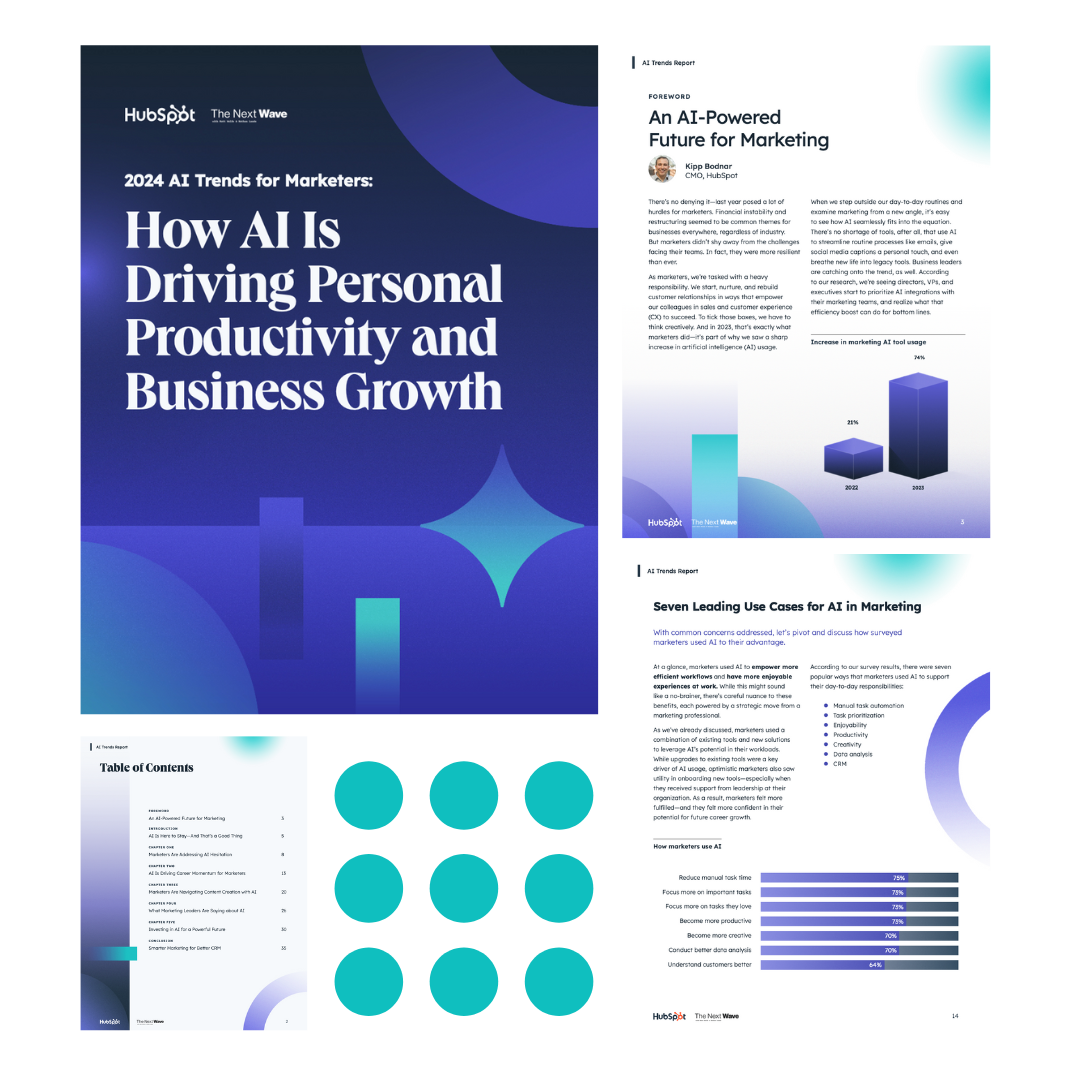There are, it would seem, as many AI marketing tools as there are stars in the sky. Do you really need to use them? Probably. Do you need a dozen of them? Probably not.

Here’s a guide to help you cut through the chaos and confusion of AI marketing analytics tools to find some that really work for your needs.
Table of Contents
How to Use AI for Marketing Analytics
Marketers are using AI in many ways: content creation, automation, efficiency and speed, and more. I talk to a lot of marketers, and it’s rare that I find somebody who isn’t using AI for something.

The State of Artificial Intelligence in 2024
New research into how marketers are using AI and key insights into the future of marketing.
- Marketing AI Tools
- Practical Tips
- Trends and Statistics
- And More!
Download Free
All fields are required.

A lot of marketers find that AI analytics tools are tremendous time-savers. Earlier this year, I spoke with Brent D. Payne, an SEO and the CEO of Loud Interactive, who told me about the proprietary AI tools he uses: “What used to take us a month to do, we have programmed — it took us three months to program it — but we have now programmed to get done in about three hours.”
For this guide, I’ve focused on just analytics tools, though there’s often overlap with uses like content creation and efficiency.
I’ve also included a couple examples of AI-powered tools for each use case, so you can get a sense of the marketing analytics landscape (and how vast it is).
That doesn’t mean you need a different tool for every step of your marketing campaign — many of them (including, ahem, HubSpot’s) use AI to provide analytics for multiple use cases.
Let’s get into it.
1. Data Analysis and Insights
Data analysis is perhaps the most obvious use for AI marketing analytics. Here’s a couple ways current tools can provide more — and faster — insights:
Social Media and Community Monitoring
As somebody who has been known to fall down a research rabbit hole or two, I like to use a mix of community research and trusted resources. (Depending on what I’m researching, a “trusted resource” might be as simple as a company website.)
That’s great for me as a consumer and less great for me as a marketer. AI tools can illuminate the dark funnel, where your potential customers might be researching via social media, Reddit, or other typically untraceable places.
Customer Feedback and Sentiment Analysis
In JPMorgan’s 2024 Business Leaders Outlook, nearly half of surveyed companies reported using AI tools like ChatGPT, virtual assistants, and chatbots. And those tools are largely being met with open (human) arms.
A 2024 study of European consumers showed an overwhelming willingness to engage with AI chatbots for customer service. (Spanish consumers were the most likely to engage, with 82% willing to speak to a bot; English consumers were the least likely, at 66%.)

HubSpot’s chatbot uses AI to help generate leads.
Although they’re ostensibly customer service and/or lead gen bots, these AI chatbots are also able to collect enormous amounts of data that yesteryear’s marketer could only dream of — sentiment analysis (is the consumer swearing in all caps? Definitely not a happy camper), demographic info, even identifying a faulty product or breakdown in customer service before it snowballs.
2. Brand Perception
HubSpot released a free tool in 2024 called AI Search Grader. You tell it a little bit about your brand; it tells you how your brand is perceived by AI search engines.

It uses sentiment analysis to determine how AI search engines perceive your brand, information that can be especially useful for marketers and SEOs who are navigating emerging AI trends in the search landscape.
I’ve used it for a few brands I’m familiar with, and I found its recommendations and analysis to be pretty spot-on.
Examples: HubSpot’s AI Search Grader, of course; AgoraPulse
3. AI Personalization
Marketers know that personalization is a key strategy for building consumer trust and brand loyalty. Savvy marketers know that “personalization” goes a lot deeper than just using a customer’s first name.
Predictive personalization can make your customer feel like your brand gets them. It can make product recommendations based on shopping history and past purchases, find emerging trends in customer behavior, and even forecast outcomes for marketing campaigns for more informed decision-making.
Examples: Optimizely, Albert.ai
Customer Segmentation and Targeting
If you’re using an email marketing platform, you’ve probably already seen AI at work when you add a subject line to your email — more often than not, there’s an option to generate a subject line using AI.
I’ve used some platforms that use AI to let you play with tone, generating and regenerating copy that’s funny, formal, or somewhere in between.
Example: Twilio’s Segment
Personalized Ads
AI can automate the creation of personalized ad variants, allowing for extensive testing of different creatives to determine which resonates best with specific audience segments.
Examples: Smartly.io, Google Ads

The State of Artificial Intelligence in 2024
New research into how marketers are using AI and key insights into the future of marketing.
- Marketing AI Tools
- Practical Tips
- Trends and Statistics
- And More!
Download Free
All fields are required.

4. Email Marketing Automation
Most email marketing platforms these days use AI to some degree, including HubSpot.
If you’re skeptical, consider this: In our 2024 State of AI in Marketing report, 75% of the thousand-plus marketers we surveyed say that using AI for automation helps them reduce the time spent on manual tasks, and gives them more time for the critical or creative aspects of their job.
You know, the fun stuff.
Other examples: ActiveCampaign, Litmus
Real-Time Updates
AI analytics tools can continuously handle and process data in real time, letting you, the marketer, adapt and fine-tune your strategies.
AI tools can update sales sequences in real-time, allowing marketers to adapt their email strategies based on current data and customer interactions to increase engagement.
Advanced A/B Testing
“A/B testing, but make it more” sounds more like a meme than a marketing tool.
But in a Marketing Against the Grain podcast episode, HubSpot CMO Kipp Bodnar says that AI is poised to take marketers from “A/B testing to A/Z testing, because the AI can do many different creative versions.”

I had to know: I used Leonardo.ai to see what it would do with A/B testing and the “make it more” meme.
We’ve even got a tool below that lets you do A/B and multivariate testing with video, by using AI to replicate a video that you create, so you can test its performance. For text-based content, this can be useful to test elements like email subject lines.
5. Mapping Customer Journeys
Mapping a customer journey by hand is an excellent way to understand the concept — and it’s a good place to start if you’re new to marketing — but it’s not the most efficient way to map at scale.
Predictive Analytics
A customer journey or buyer’s journey describes the processes your customer (or buyer) goes through when they interact with your brand.
As AI gathers data on your current customers as they move through the funnel, it can predict likely next steps, anticipate obstacles, and identify opportunities for personalization.
Real-time Journey Optimization
Like real-time updates in email platforms, AI can continuously monitor and analyze customer journeys.
That might mean adapting the journey, depending on the customer’s preferences, or figuring out the best times to trigger personalized content or offers.
Tools for Marketing Analytics
- Breeze by HubSpot
- 1Mind
- 6sense
- Common Room
- Humantic.ai and TryScout.ai
- Icon
There are dozens (and dozens) of AI marketing tools available. Here’s a few that HubSpot AI pros are talking about:
1. Breeze by HubSpot

Breeze, HubSpot’s AI, has three tools to provide assistance: Breeze Copilot, Breeze Agents, and Breeze Intelligence.
Breeze Copilot (formerly known as ChatSpot) works with AI and your CRM data to help you get work done faster without sacrificing quality.
Breeze Agents can help teams automate work and provide tactical knowledge, and Breeze Intelligence can identify your target market, gauge the intent of website visitors, and enrich contact and company data within HubSpot.
Breeze Intelligence in particular, which consists of over 200 million buyer and company profiles, has deep analytical capabilities. It can help you improve form conversion rates, identify buyer intent from companies visiting your website, and keep your database fresh with regular updates.

Breeze social media agent is one example of how analytics can save you time and brainspace: It uses your past performance, business details, and industry best practices to make your social media content more effective.
Bonus: 95% of our customers say that our AI is easy to use.
2. 1Mind

If you’ve ever started a new customer-facing job, you’ve likely had interactions where you realized that you hadn’t accumulated enough institutional knowledge to answer questions and solve problems with ease.
1Mind was designed to overcome that problem with an all-knowing (about your product or service, at least) AI avatar that can deliver a human-like chat experience to customers.
Watch HubSpot marketing SVP Kieran Flanagan talk to the AI avatar of One Mind creator Amanda Kahlow:
3. 6sense

HubSpot contributor Brian Grover writes of 6sense, “I’ve found that when only a small fraction of a total addressable market is buying at any given time, having insight into who is actually looking can turn marketing from guesswork into a predictable pipeline."
Grover says that the newest iteration of 6Sense "has AI sifting through the massive amount of intent data to surface actionable insights” — which lets your team focus on the highest-value tasks and activities.
Pro tip: Grover says that 6Sense “can help you match buying signals to accounts across devices and channels.”

The State of Artificial Intelligence in 2024
New research into how marketers are using AI and key insights into the future of marketing.
- Marketing AI Tools
- Practical Tips
- Trends and Statistics
- And More!
Download Free
All fields are required.

4. Common Room

One of the first things I do when researching a product or service I might want is to see what everybody else is saying.
That might be as simple as looking at Yelp reviews for a new restaurant, but I’ve also used X and Threads to ask my peers for recommendations.
HubSpot has approximately one (1) zillion Slack channels, and I’ve used it to get movie recommendations and even find a roofer.
Since that’s how most consumers do their research these days, one of Common Room’s services is an AI-powered playbook that can identify ideal customer profiles (ICP) in your community.
If you have a Slack community or use a support forum like Discourse, you can create an ICP in Common Room, which helps you “identify ideal customers in your community” and alert your team when “an ICP is active in the dark funnel,” that is, the untraceable places consumers talk about your service or product, like text messages, word of mouth, or third-party review websites.
Pro tip: Common Room integrates with HubSpot — so if you’re already a HubSpot user, check out Common Room’s HubSpot integration guide.
5. Humantic.ai and 6. TryScout.ai

In a Marketing Against the Grain podcast episode, Flanagan describes TryScout.ai as a tool “that allows you to ingest data and build campaigns around that data that are very personalized.”
Humantic.ai, Flanagan says, is “very similar,” helping marketers figure out their ideal customer profile.

These platforms are focused on extracting intelligence from buyer data and crafting personalized campaigns or messages.
Pro tip: TryScout.ai works with LinkedIn to pull leads, and it fills in the blanks that the briefcase app leaves open, like emails and phone numbers.
7. Icon

HubSpot CMO Kipp Bodnar describes Icon as “basically [taking] one video — they're even matching you with a creator — then … making 20, 50, however many versions of that video. And then testing them all against each other to see what performs the best.”
HubSpot marketing SVP Kieran Flanagan and Bodnar’s co-host on the Marketing Against the Grain podcast, notes that creator ads tend to perform better than just about anything else “because it brings in an authentic voice.”
Once a creator makes one video, Icon can turn it into 20 and do granular A/B testing on hooks, stories, and calls to action.
Pro tip: Flanagan says that if you’re in a space with a lot of creators, and if advertising is core to how you acquire new demand, you’re well positioned to use a tool like Icon. He suggests experimenting with attaching Icon to your paid advertising and seeing how well those ads run.
Save Time with AI
A lot of folks I talk to remain skeptical about AI, particularly as it’s being used in content creation and other creative tasks.
But when I talk to people who are actually using AI day in, day out, there’s a common thread: AI can’t replace human brains, but it can make a lot of mundane tasks a whole lot faster.
Any of the tools above will let you dip your toes in the AI waters — and give you some time back to do the creative and strategic tasks that you’re great at.

The State of Artificial Intelligence in 2024
New research into how marketers are using AI and key insights into the future of marketing.
- Marketing AI Tools
- Practical Tips
- Trends and Statistics
- And More!
Download Free
All fields are required.

![Download Now: The Annual State of Artificial Intelligence in 2024 [Free Report]](https://no-cache.hubspot.com/cta/default/53/b72f2b25-8cc9-4642-9a1b-1e675d3d273b.png)



![Real or AI-Generated? You Guess [Quiz]](https://www.hubspot.com/hubfs/real%20or%20ai.png)

![AI Predictions that Could Impact Marketers in 2025 [Trending Data & Expert Insights]](https://www.hubspot.com/hubfs/AI%20predictions.png)



